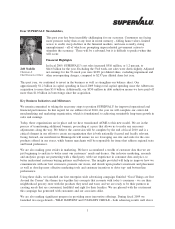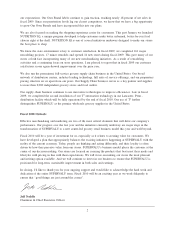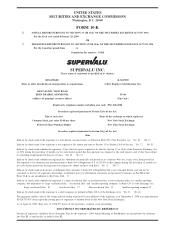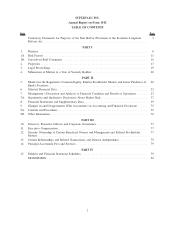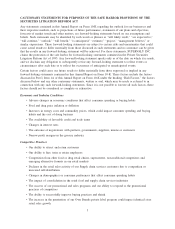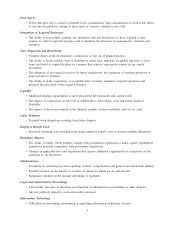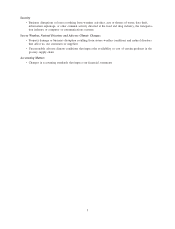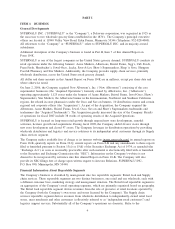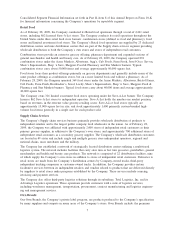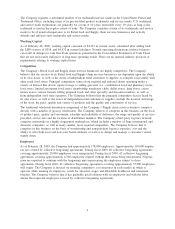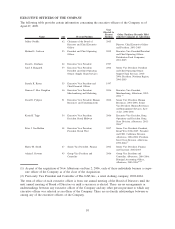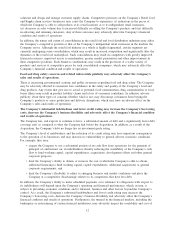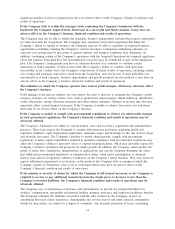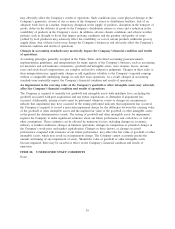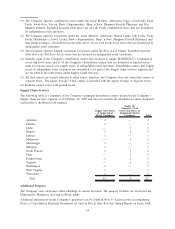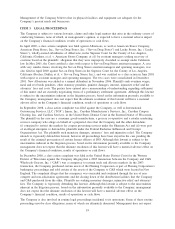Albertsons 2009 Annual Report Download - page 13
Download and view the complete annual report
Please find page 13 of the 2009 Albertsons annual report below. You can navigate through the pages in the report by either clicking on the pages listed below, or by using the keyword search tool below to find specific information within the annual report.The Company registers a substantial number of its trademarks/service marks in the United States Patent and
Trademark Office, including many of its private-label product trademarks and service marks. U.S. trademark
and service mark registrations are generally for a term of 10 years, renewable every 10 years as long as the
trademark is used in the regular course of trade. The Company considers certain of its trademarks and service
marks to be of material importance to its Retail food and Supply chain services businesses and actively
defends and enforces such trademarks and service marks.
Working Capital
As of February 28, 2009, working capital consisted of $4,363 in current assets, calculated after adding back
the LIFO reserve of $258, and $4,472 in current liabilities. Normal operating fluctuations in these balances
can result in changes to cash flow from operations presented in the Consolidated Statements of Cash Flows
that are not necessarily indicative of long-term operating trends. There are no unusual industry practices or
requirements relating to working capital items.
Competition
The Company’s Retail food and Supply chain services businesses are highly competitive. The Company
believes that the success of its Retail food and Supply chain services businesses are dependent upon the ability
of its own stores, as well as the stores of independent retail customers it supplies, to compete successfully with
other retail food stores. Principal competition comes from regional and national chains operating under a
variety of formats that devote square footage to selling groceries (i.e., combination food and pharmacy stores,
food stores, limited assortment food stores, membership warehouse clubs, dollar stores, drug stores, conve-
nience stores, various formats selling prepared foods and other specialty and discount retailers), as well as
from independent food store operators. The Company believes that the principal competitive factors faced by
its own stores, as well as the stores of independent retail customers it supplies, include the location and image
of the store, the price, quality and variety of products and the quality and consistency of service.
The traditional wholesale distribution component of the Company’s Supply chain services business competes
directly with a number of grocery wholesalers. The Company believes it competes in this business on the basis
of product price, quality and assortment, schedule and reliability of deliveries, the range and quality of services
provided, service fees and the location of distribution facilities. The Company’s third-party logistics network
competes nationwide in a highly fragmented marketplace, which includes a number of large international and
domestic companies, as well as many smaller, more regional competitors. The Company believes that it
competes in this business on the basis of warehousing and transportation logistics expertise, cost and the
ability to offer both asset and non-asset based solutions as well as to design and manage a customer’s entire
supply chain.
Employees
As of February 28, 2009, the Company had approximately 178,000 employees. Approximately 110,000 employ-
ees are covered by collective bargaining agreements. During fiscal 2009, 60 collective bargaining agreements
covering approximately 29,000 employees were renegotiated. During fiscal 2009, 62 collective bargaining
agreements covering approximately 4,500 employees expired without their terms being renegotiated. Negotia-
tions are expected to continue with the bargaining units representing the employees subject to those
agreements. During fiscal 2010, 47 collective bargaining agreements covering approximately 37,000 employees
will expire. The Company is focused on ensuring competitive cost structures in each market in which it
operates while meeting its employees’ needs for attractive wages and affordable healthcare and retirement
benefits. The Company believes that it has generally good relations with its employees and with the labor
unions that represent employees covered by collective bargaining agreements.
9


